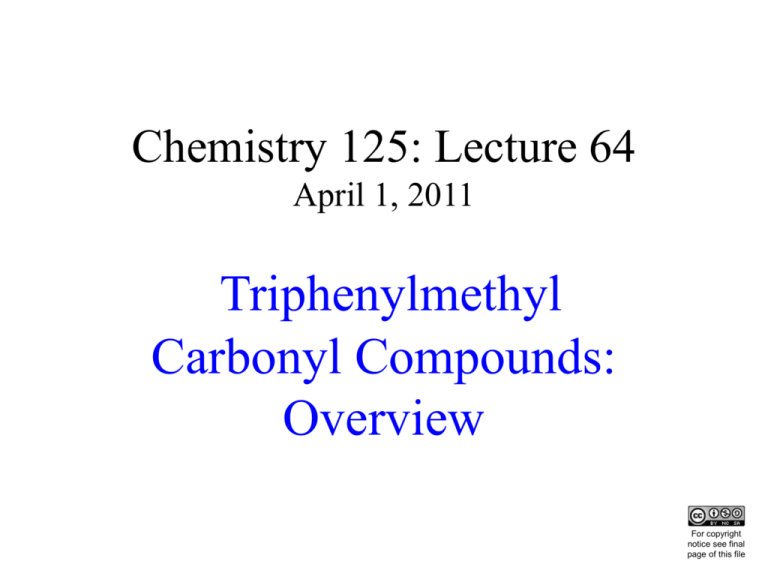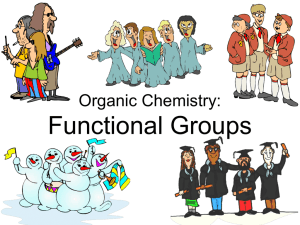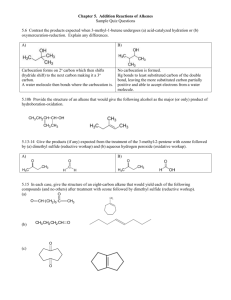
Chemistry 125: Lecture 64
April 1, 2011
Triphenylmethyl
Carbonyl Compounds:
Overview
This
For copyright
notice see final
page of this file
Ph3C
Propeller
Conformation
Ph
H-H contact
prevents
bonding
Two Ph3C
Propellers
Hopelessly
Remote
Steric hindrance in triphenylmethyl causes twists that
reduce overlap with 2pC by 25% from diphenylmethyl.
It also makes tetraphenylmethane very difficult to prepare,
not to mention hexaphenylethane !
Tetraphenylmethane (1897)
“I have tried to solve this problem
in a completely different way.”
Friedel-Crafts
or
Ph2Mg
?
110°
Cu
0.3 g
8g
Solubility
Analysis : C 93.32 (93.75) H 6.36 (6.25)
100 mg for Mol. Wt. : 0.289°
306 (320 calc.)
(by solvent b.p. elevation)
Back in Ann Arbor (1898-9)
Confirmed Mol. Wt. 0.285°
Prepared O2N-
318 (320 calc.)
- 4C (99.5% yield)
“Unlike the trinitrotriphenylmethane… it does
not dissolve in sodium ethylate, nor does it give
any coloration…”
OHow
- 3C-HO2
2N- about
EtO
N-
O2N-- 3 C-C
- + EtOH
--NO
C
3
2 3?
Prepared "Hexaphenylethane"
Ph3C-Cl
Zn
O
failed for
2
preparing
PhPh
OCPh
3CO
3C-CPh
3 3
( C+H = 93.82% )
Ph, CPh
3
C+H = 93.97
94.20
, 94.00 , 94.57%
from first 4 methods.
Reported more than 17 methods.
Prepared authentic peroxide from Na2O2 (SN2).
Prepared hydrocarbon in CO2 atmosphere
using special apparatus with ground glass joints.
Free Radical! (1900)
Highly “Unsaturated” (O2, Cl2, Br2, even I2!)
Launched an American Century of Chemistry
October, 1900
AlCl3/C-Electrophile: The Friedel-Crafts Reaction
MIT
President
Paris (Friedel - Mines)
MIT
Gibbs
Equilibrium
1876-8
Cornell
Paris (Wurtz - Médicine)
1877
Launching the American Chemical Century
Moses Gomberg Publications (1888-1942)
Munich-Heidelberg
Two Gomberg papers from this period
contained more graphs than all
4290 pages of Berichte in 1900.
CPh4 •CPh3
(1896)
(1900)
age
Second Thoughts
on
Friedel-Crafts
This
Rearrangement in Friedel-Crafts Alkylation
Where?
2/7
Deno (1968)
+
3/7
Cl
D+ 3
AlCl
+
gives i-PrPh
product
H
2/7
with
one D
+
H
What if CH3 gets
gives stuck halfway?Which of
these gives
n-PrPh
+
Still
+
the
n-PrPh
product
CH
gives
3 product in
+
n-PrPh
Cl
FriedelNu
product!
Protonated Crafts?
AlCl3
Cyclopropane
Hydride Shift
(stability between
1° and 2° cations)
CH3
+
Cl
AlCl3
PROBLEM:
why not
How
to Shift?
Methide
Still
gives
n-PrPh
product
Carbonyl Compounds
e.g. J&F Chapters 16-19
(268 pages!)
This
Good News:
Much of this is review!
Chapter 16: Aldehydes & Ketones
C=O Stable, but Reactive!
Average Bond Energies
(kcal/mole)
C-C
83
C=C 146
“second bond” 63
C-O
86
C=O 176 (aldehyde)
179 (ketone)
90
93
(more substituted sp2C)
O
HC
CHn
199.6
31.2
201.8
37.6
5.2
201.6
45.7
15.7
35.3
209.3
35.3
7.3
29.3
206.6
45.2
17.5
28.8
206.3
36.4
7.6
30.2
205.1
30.2
13CMR
7.3
CH3
202.0
CHn
CH3
13.3
13.5
CHn
C CHn CHn CH3
O
100 MHz 13CMR Spectrum
Proton Decoupled
(from Chem 220)
Use table to identify this compound
43.3
13.4
22.1
23.9
J=
1.8 Hz
9.76
J=
6.8 Hz
20 Hz
2.42
1.59
1.35
400 MHz PMR Spectrum
(from Chem 220, corrected with d from SDBS#10637)
same compound
0.93
Carbonyl Reactivity
*
H+
O
O
O
L
L
Nu
Nu
Nu
1) Nucleophilic Addition 2) Nucleophilic Substitution
(Bürgi-Dunitz Angle)
of “Acid Derivatives”
Chapter 16
(C=C prefers “Electrophilic” addition)
especially interesting for alcohol synthesis
Nu = “R-” (e.g. CH3Li)
Nu = “H-” (e.g. LiAlH4)
Secs. 16.13,16.16
(A/D, like Aromatic)
Chapter 18
Carbonyl Reactivity
n (acid catalysis)
A
H
O
O
H
Nu
H Nu
HO
O
B
H
-proton
3) Electrophilic Addition (Easier than for C=C)
the enol is
then Nucleophile
a carbon
H (gem-diol)
nucleophile
H
HO
Hydrate
O
O
O
Hemiacetal ( Acetal)
A RO
A
A
RNH Carbinolamine ( Imine)
HOSO2 Bisulfite addition product
4) Allylic
5) Substitution
Cyanohydrin
(Electrophilic) NC
Rearrangement
Chapter
19
etc. Secs.
16.6-16.11
Ketone to Enol
Enols, Enolates and Enolization
(base catalysis) Chapter 19
Kenol formation
pK
a
O
B
H
O
O
19
9
O
-3
O
510-9
H
pKa~11!
(ketone ~11 kcal below enol)
3
(ketone enol
help from conjugation,
H-bonding)
O
H
O
OH
>1013
(ketone >17 kcal above enol
help from aromaticity)
pKa = 10
(anion only
~13 kcal/mol
above phenol)
RCOOH Reactions
addition
(Chapter 17)
OA
substitution
at C
substitution
at -C
R C
H
R
O
Nu
H
substitution
at O
Mechanism for Acid-Catalyzed Hydrolysis of Acetal
(pp. 785-787)
:
First remove RO, and replace it by HO.
Good News: Much of this is review! e.g. secs. 16.9-16.10
H+
ROH
+ H
RO
RO
+
+
CH2
RO=CH2
CH2
RO-CH2
cation unusually stable;
RO
RO
thus easily formed
HOH
Now remove second RO, then H (from HO)
+
H
ROH
+ H
RO
RO
RO
+
CH2
CH2
H-O-CH2
+ CH2
HO
HO
HO
(hemiacetal)
H
ROH
RO
H
Overall Transformation:
O=CH
CH2 O
O=CH2
H+
RO
H
H2O + Acetal
Carbonyl + 2 ROH ROH
Ph
Ph3C
Mirror
Conformation
Ph
Ph3C
Propeller
Conformation
Ph3C-Ph
Two Mirrors
rotated
a bit
End of Lecture 64
April 1, 2011
Copyright © J. M. McBride 2011. Some rights reserved. Except for cited third-party materials, and those used by visiting
speakers, all content is licensed under a Creative Commons License (Attribution-NonCommercial-ShareAlike 3.0).
Use of this content constitutes your acceptance of the noted license and the terms and conditions of use.
Materials from Wikimedia Commons are denoted by the symbol
.
Third party materials may be subject to additional intellectual property notices, information, or restrictions.
The following attribution may be used when reusing material that is not identified as third-party content:
J. M. McBride, Chem 125. License: Creative Commons BY-NC-SA 3.0








